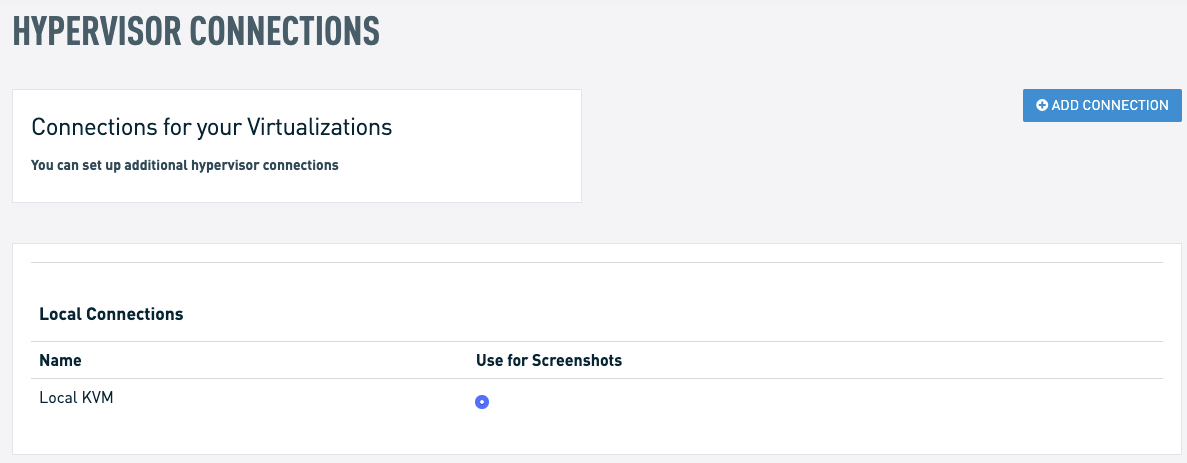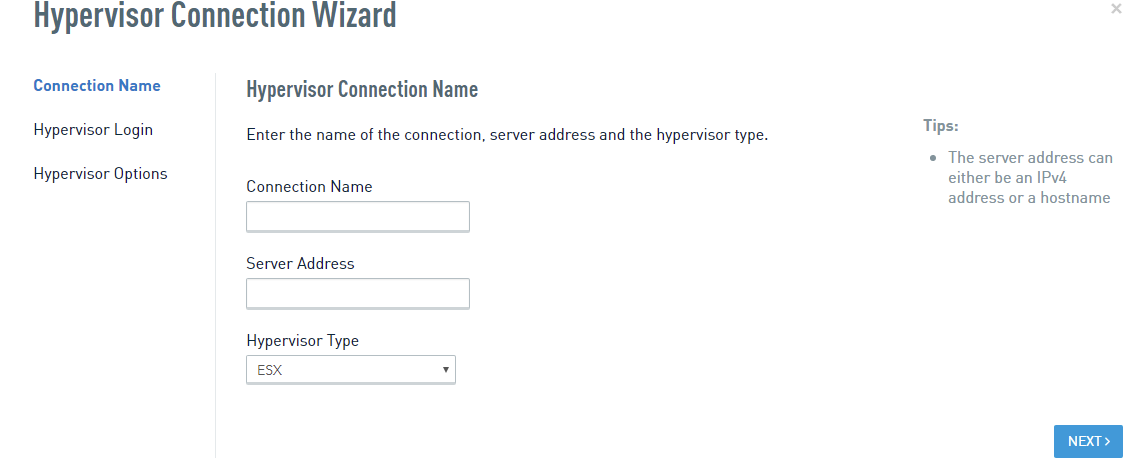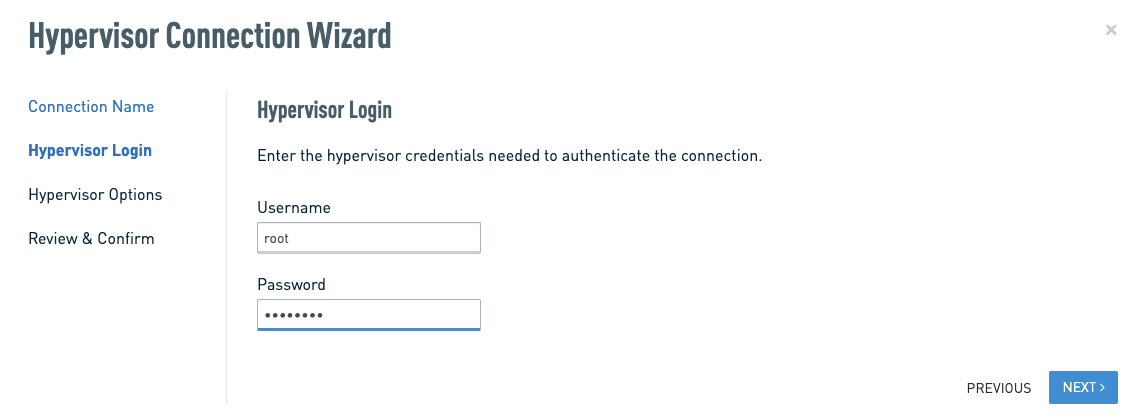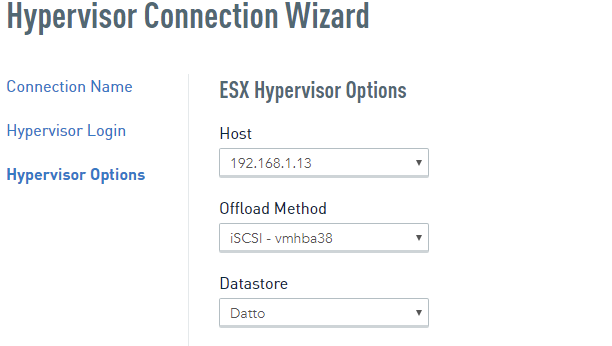Connecting a SIRIS to a VMware Hypervisor
This article explains how to connect a SIRIS to a VMware hypervisor.
Environment
- Datto SIRIS
Description
These instructions apply to virtual and physical SIRIS appliances to enable agentless backups, ESXi Virtualizations, and ESXi uploads. For Hyper-V instructions, see Connecting a SIRIS to a Hyper-V Hypervisor.
System Requirements
Datto SIRIS supports hypervisor connections to the following PAID versions of VMware vSphere:
- VMware vSphere 6.0
- VMware vSphere 6.5
- VMware vSphere 6.7
- VMware vSphere 7.0
- VMware vSphere 8.0
For a complete list of prerequisites, see Getting started with agentless backups
Procedure
To back up a virtual machine hosted on VMware vSphere, you must set up a connection to the hypervisor. This connection enables automatic screenshots and virtualization.
In the Datto device GUI, click Configure >Hypervisor Connections >Add Connection.

Add a Connection Name and Server Address. The Hypervisor Type will default to ESX. Use this setting to create an ESXi connection.

- Always enter the highest-level connection for the Server Address; the Datto will autodetect your ESXi environment. Use the IP address of the vCenter server that manages the host.
- If you are using a clustered environment, use the IP/FQDN for either the vSphere Client or the web client.
Fill in the fields for the Hypervisor Login.

- The account that the Datto appliance uses to connect to the hypervisor must be one of the following types:
- A Domain Administrator for the vCenter instance
- A root account on the hypervisor
If the the password for the account used to create the connection changes, you will need to edit the hypervisor connection on the Datto to use the new password.
- The account that the Datto appliance uses to connect to the hypervisor must be one of the following types:
Specify your ESXi Hypervisor options. If you are connecting to a vCenter managed environment, you will be prompted to specify:
- Data Center
- Cluster
- Host Address within vCenter
- Offload Method (NFS/iSCSI)
- Datastore
- Network Adapter
If you are connecting to a standalone environment, you will be prompted for:
- Offload Method (NFS/iSCSI)
- Datastore
- Network Adapter
If you choose to connect to the standalone host, you will have to configure a connection for each one you wish to back up agents from, use for screenshot offloading, or restore to.
Once you click Next, the Datto appliance will connect to the hypervisor and display your connections.

The HYPERVISOR CONNECTIONS window displays the settings for your connections. Note that the Use for Screenshots radio button is selected by default. This option leverages snapshots generated by the hypervisor for use in screenshot verification.
You can now add VMs for backup using the System Backup Wizard.
Offload method considerations
NFS:
- Can easily migrate in case of disaster recovery after virtualization
- No extra steps to set up the connection
iSCSI:
- You offload via RDM mapped drives. When using vMotion (external link), ESXi will move RDM mapped VMDKs normally. The RDM mapped VMDKs, however, are equivalent to symlinks.
- iSCSI is more secure then NFS.
- ISCSI requires setting up an extra vmKernel port.
NOTE Your Datto appliance will only display the Cluster and Datastore fields if they apply to the type of connection you are configuring.
- When adding a datastore, specify a location to store the virtual machine during ESXi virtualization and screenshot verification.
- The location can be a different datastore than where the virtual SIRIS appliance virtual machine is located.
- The datastore should have enough space to hold the .vswap file for each ESXi virtualization.
- Each .vswap file is equal to the amount of memory allocated to the virtual machine.
- You use the iSCSI adapter on the ESXi host for ESXi virtualization.
- For proper iSCSI connection and RDM creation, the adapter should be on the same subnet as one of the NICs on the SIRIS appliance.
- If you use a software iSCSI adapter, then it should be bound to a VMkernel adapter on the same subnet as one of the NICs on the SIRIS appliance.
If you don't already have an iSCSI adapter set up on your ESXi host, see page 69 of vSphere (external link) for instructions.
Updating Connection Credentials
If you need to update the hypervisor credentials for an existing connection, click the pencil icon on the right side of your hypervisor connection listing. The connection wizard will re-launch and allow you to make changes without having to re-boot or re-connect the hypervisor.
Frequently asked questions
When using a clustered environment, you must connect to the vCenter management server. If you use a standalone connection with a cluster the vmID of any virtual machine could change if it is vMotioned. Because the standalone connection only uses this vmID, backups will fail until you determine the replacement vmID value and re-associate the backup chain to it.
VMware has two values that it uses to assign each virtual machine:
- A unique identifier (vmID). vmIDs are unique at the ESXi host level.
- The Managed Object Reference ID (MoRefID). MoRefIDs are unique across an entire vCenter cluster.
You can tell the difference between a MoRefID and a vmID by their format. The prefix vm- will precede a MoRefID, but a vmID will not have a prefix. For example, vm-9463.
If you start agentless backups via a standalone connection, then switch to a vCenter cluster connection, you must change all vmIDs to MoRefIDs on the back-end of the device to get backups running again.
In the Hypervisor Connection Wizard, if the system displays a Cluster field on the Hypervisor Options pane, then it represents the selected cluster. In all other cases, it represents a hypervisor host.
For existing hypervisor connections, you can go to the Hypervisor Connections page and check the ESX Connections. If the Type column says Cluster, then it represents a cluster. Otherwise, it represents a hypervisor.
The existing connections do not show which cluster or host it represents. Using a descriptive name for the hypervisor connection is recommended to track this.
To provide a means to access the Offload Method.
The Datto appliance uses the Offload Method to create new VMs in the vCenter cloud. It does not use this method to perform the actual backup itself.
The following features use the Offload Method:
- Restore (Virtualize via Hypervisor)
- Screenshot Verification
Yes. This is rarely needed, if ever, but it is allowed. Since the same cluster is paired twice, you will see the list of VMs twice in the "Protect a System" wizard - once for each hypervisor connection.




